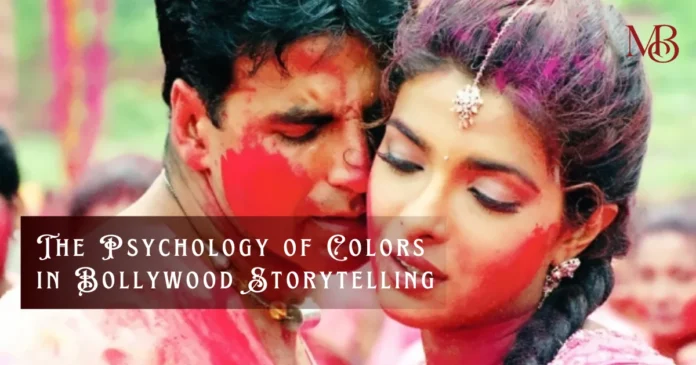Colors in Bollywood: Bollywood, the magical dream factory, knows how to weave emotions, drama, and unforgettable visuals into its narratives. But have you ever paused to think about how colors tell their own stories? Yes, those vibrant hues on-screen are more than just a treat for your eyes; they’re carefully chosen to tug at your heartstrings, highlight conflicts, or even foreshadow plot twists. So, grab some popcorn, and let’s dive into the psychology of colors in Bollywood storytelling—a world where every shade has a purpose.
Colors in Bollywood Red: Love, Danger, and Passion Collide
Red is Bollywood’s all-time favorite color, and why wouldn’t it be? It’s bold, intense, and impossible to ignore. Think of classic moments like Simran running through a mustard field in Dilwale Dulhania Le Jayenge. Her red dupatta doesn’t just flutter in the wind; it symbolizes love, longing, and fiery passion.
But hold on! Red isn’t always about romance. It can scream danger, too. Remember the ominous red saree of Madhuri Dixit in Devdas? It hinted at heartbreak, destruction, and untamed emotions. In Bollywood, red often walks a fine line, making your heart race—sometimes with joy and other times with dread.
Colors in Bollywood Blue: Calm Waters or Emotional Turmoil?
You’re probably thinking, “Blue? Isn’t that just serene and calming?” Well, Bollywood knows how to flip that script! Blue often represents depth, melancholy, or even suppressed emotions.
Take Tamasha, for instance. The serene blue Mediterranean waters are a stark contrast to Ved’s (Ranbir Kapoor) inner chaos. The color reflects his yearning for freedom and self-discovery. Then there’s Dil Chahta Hai, where blue skies and oceans symbolize the carefree spirit of youth but also the emotional undercurrents threatening friendships.
Here’s the kicker: Blue’s duality lets you decide—do you feel soothed or unsettled? Bollywood loves to leave that choice up to you.
If you liked Colors in Bollywood then you might also like: Bollywood Movies from A to Z Alphabets: A Complete List of Iconic Films
Colors in Bollywood Yellow: Hope and Transformation
Bollywood often uses yellow as a symbol of hope, warmth, and transformation. It’s like that ray of sunshine breaking through stormy clouds. Remember Queen? Rani (Kangana Ranaut) dons a yellow dress during her Parisian adventure. It’s a sign of her newfound confidence and independence.
Yellow can also mean caution. In Kahaani, Vidya Balan’s yellow maternity dress seems harmless, but it conceals secrets, much like her character’s deceptive simplicity.
Every time yellow pops up on-screen, it’s asking you to notice the shift—a character’s growth, a brewing conflict, or maybe just hope for a better tomorrow.
Colors in Bollywood Black and White: Morality in Monochrome
Bollywood loves to play with black and white, especially when it’s time to show morality. White often symbolizes purity, truth, and innocence, like Madhubala’s angelic white outfits in Mughal-e-Azam. But don’t let it fool you; white can also signal grief and loss, as seen in Baghban.
Black, on the other hand, is Bollywood’s go-to color for villains. Think of Gabbar Singh’s iconic black attire in Sholay. Black screams danger, power, and mystery. But sometimes, it flips the script, like Amitabh Bachchan’s Don, where black isn’t just evil—it’s thrilling, charismatic, and irresistibly stylish.
Here’s the trick Bollywood pulls: black and white aren’t always opposites. They’re often used together to blur the lines between good and bad, leaving you guessing.
Colors in Bollywood Green: Nature, Envy, or a Fresh Start?
Green is Bollywood’s subtle whisper—it’s there, quietly enriching the story. It’s often used to symbolize nature, growth, or renewal. Think of the lush greenery in Swades, reflecting Mohan’s (Shah Rukh Khan) connection to his roots and eventual transformation.
But wait—green isn’t all sunshine and rainbows. It can also represent jealousy or greed. In Om Shanti Om, Shanti’s green outfit in a crucial scene hints at the envy and betrayal simmering beneath the surface.
So, when Bollywood paints the screen green, it’s telling you to look deeper—there’s more than meets the eye.
Colors in Bollywood Contrasting Colors: When Opposites Attract… or Attack
Bollywood thrives on drama, and what better way to heighten it than by throwing contrasting colors into the mix? Think of Ram-Leela. The fiery reds of Leela’s wardrobe clash beautifully with the cool blues surrounding Ram, visually representing their love-hate relationship.
Contrast also symbolizes conflict. In Padmaavat, the stark difference between Padmavati’s serene whites and Khilji’s menacing blacks highlights their opposing moral compasses.
These contrasts aren’t just visually striking; they subconsciously nudge you to feel the tension, the chemistry, or the chaos brewing on screen.
Colors in Bollywood Foreshadowing Through Colors
Bollywood directors are sneaky—they love dropping hints about future plot twists using colors. In Kabhi Alvida Naa Kehna, Rani Mukerji’s shift from pastel to darker tones mirrors her inner turmoil and the forbidden affair she steps into.
Or take Lagaan, where earthy tones dominate the villagers’ wardrobes, subtly foreshadowing their grounded resilience and determination.
If you’re sharp enough, you’ll start spotting these breadcrumbs, making you feel like a detective unraveling the story before it unfolds.
Also read: How Colors Secretly Shape Bollywood Movies (And How You Can Spot It!)
Colors in Bollywood Songs: When Colors Dance to Emotions
No discussion of Bollywood colors is complete without its iconic song sequences. Remember Taal? The song “Taal Se Taal Mila” uses blues and whites to depict spiritual love, while contrasting hues in Dola Re Dola reflect fiery passion and underlying rivalry.
Songs are Bollywood’s ultimate color playground, letting emotions explode in every shade imaginable. Next time you watch a song, pay attention—the colors are doing their own jig in the background.
You might also like: 10 Unforgettable Colors in Bollywood Songs
How You Can Spot These Color Cues
Now that you’re clued into Bollywood’s color psychology, watching movies will never be the same. Start noticing:
- How does a character’s wardrobe evolve?
- What’s the dominant background color in emotional scenes?
- Are contrasting colors signaling conflict or chemistry?
Trust us; once you unlock this visual language, every Bollywood movie will feel like an entirely new experience.
Bollywood’s Secret Palette of Emotions
Bollywood’s use of color isn’t just about aesthetics; it’s a storytelling tool as powerful as its music, dialogue, or acting. From red’s fiery passion to black’s menacing mystery, every shade on the screen whispers secrets about the characters and their journeys.
Read more: Bollywood’s Color Code: Spot the Secret Messages in Your Favorite Movies
So, the next time you sit down for a Bollywood binge, keep an eye out for these visual cues. You’ll see how colors not only beautify the story but also help you feel it in ways you never imagined. And who knows? You might just start seeing your world in a whole new light too! Follow our culture page for more.


